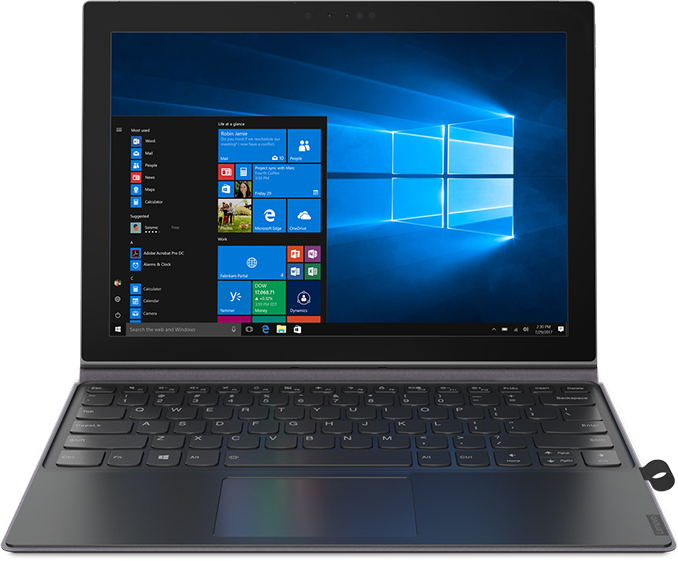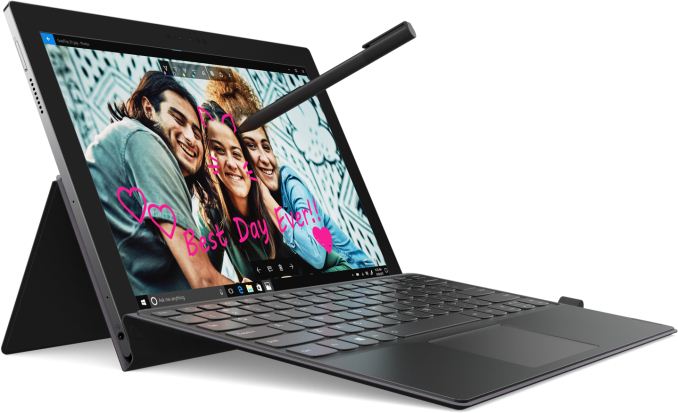Lenovo’s Miix 630 Snapdragon 835-Based 2-in-1 Now Available
by Anton Shilov on July 10, 2018 3:00 PM EST- Posted in
- Laptops
- Systems
- Lenovo
- Arm
- Tablets
- Windows 10
- Snapdragon 835
- SD835
- Miix 630

Lenovo has started to sell its Miix 630 always-connected PC based on Qualcomm’s Snapdragon 835 SoC and Microsoft’s Windows 10 S. The system weighs around 1.4 kilograms yet promises up to 20 hours of battery life with a perminent connection to the internet when in cell-tower coverage.
Lenovo’s Miix 630 is a 2-in-1 detachable notebook with a 12.3-inch FHD+ display and a 15.6 mm z-height when equipped with a keyboard. The system is outfitted with Qualcomm’s Snapdragon 835 SoC, 4 GB of LPDDR4-1866 memory, 128 GB of UFS 2.1 storage, 2x2 802.11ac Wi-Fi, Bluetooth 4.1, and an integrated Gigabit LTE modem. Since the Miix 630 uses a mobile SoC, it is always connected to a 4G/LTE network and offers a very long battery life because it is equipped with a laptop-class 48 Wh battery: Lenovo rates the system for 20 hours of video playback at 150 nits screen brightness.
The 2-in-1 comes with Microsoft’s Windows 10 S, but there is an option to upgrade to Windows 10 Pro for free within the first 180-days after initial registration. Since the Snapdragon 835 is designed to be more space and efficient than the competition, the Miix 630 is rated to work significantly longer than the vast majority of ultra-thin notebooks.
As reported previously, the platform supports applications through the Windows Store that are natively compiled for the S835, as well as non-native 32-bit apps through machine translation. Qualcomm is still in the middle of developing its 64-bit SDK, as well as looking into translation of non-native 64-bit apps. We covered the topic when Qualcomm announced the Snapdragon 850. For some power users, this may be a limitation at this time, however most regular program suites for business use are ready and operational for full performance.
Lenovo charges $899.99 for the Miix 630 product, which is the price that Microsoft charges for its entry-level Surface Pro 4 2-in-1 that is powered by Intel’s Core m3-6Y30 SoC.
Lenovo’s Miix 630 is now available both directly from Lenovo as well as from retailers like Amazon.
| The Lenovo Miix 630 | ||
| Specifications | ||
| Display | 12.3" 1920×1280 187 PPI 400 nits |
|
| CPU | Qualcomm Snapdragon 835 4 x Kryo 280 Performance (2.45 GHz) 4 x Kryo Efficiency (1.9 GHz) |
|
| Graphics | Adreno 540 GPU at 710 MHz | |
| RAM | 4 GB | |
| Storage | 128 GB + microSD | |
| Wi-Fi | 2×2 802.11ac Wi-Fi | |
| Bluetooth | Bluetooth 4.1 | |
| WWAN | Qualcomm X16 Gigabit LTE | |
| USB | 3.0 | 1 × Type-C |
| Cameras | Front | 5 MP with IR and Windows Hello |
| Rear | 13 MP | |
| Other I/O | Microphone, stereo speakers, audio jack, trackpad, card reader, etc. | |
| Battery | 48 Wh | |
| Battery Life | 20 hours | |
| Dimensions | Width | 293 mm | 11.5" |
| Height | 210 mm | 8.2" | |
| Thickness | 15.6 mm | 0.6" w/ keyboard | |
| Weight | 1.39 kilograms | 2.93 lbs | |
Related Reading
- Qualcomm Announces Snapdragon 850: A Second Generation For Windows
- HP’s Snapdragon 835-Based Envy X2 2-in-1 Available for Pre-Order, Starts at $999
- Lenovo Unveils Miix 630 2-in-1: Windows 10 S, Snapdragon 835, Gigabit LTE, 20 Hrs
- ASUS Announces the NovaGo (TP370): A Snapdragon 835 based Windows 10 PC
- Microsoft Launches Windows 10 On ARM: Always Connected PCs
- Microsoft and Qualcomm Collaborate to Bring Windows 10 & x86 Emulation to Snapdragon Processors
Source: Lenovo (via Liliputing)












34 Comments
View All Comments
PeachNCream - Tuesday, July 10, 2018 - link
Battery life is awesome, but the $900 price is going to limit sales. I really think the cost has to be much lower than the current generation of Snapdragons running Windows so there's broader appeal and greater adoption. Then again, ARM-based phones can reach that price point as well without good underlying reasons. Also hurting it is the problem of translation for x86 programs that aren't able to execute natively on the underlying metal.Dragonstongue - Tuesday, July 10, 2018 - link
I think based on specs and specs alone that is listed considering the "size" $900 is "about" what I would expect especially given the sheer battery size, direct comparison my moto G4 Play battery is somewhere in the range of AT BEST (if my maths are correct) something like 10 watt hours (something like that)2800Mah 3.8v (spec)
that being said, much larger battery than any phone I am aware of (though 20 hours does not seem like all that much though I suppose it depends on their testing, does that mean full brightness full system 100% loaded (as it should be) to give a more truthful rating?
much larger screen size 12.3 inch than android cellphone (obviously) so more or less a "netbook" screen size and +/- ipad size (depending on generation which are 9.7-12.9 inch while most netbooks tend to be n the 7 to 12.1 inch screen size with MUCH higher resolution etc etc.
I am not "fond" of the price point, but then again, I hate the price of the stupid easy to break no headphone all glass BS smartphones this day and age, so $900 seems "about right" without being greedy on a toy size device (pretty much all smartphones no matter their size) with many costig in the $580-$1300+ range with average battery size in the ~1500-5800Mah.
to each own, this seems like "a good purchase" for the price they are asking, though they could have probably used a smaller discrete gpu from Radeon instead of a Adreno ^.^
DanNeely - Tuesday, July 10, 2018 - link
The adreno is already part of the Snapdragon 835 SoC. A discrete GPU would require not just PCB space for the GPU and its Vram, but that the 835 be modified to provide a PCIe bus for it and the GPU to talk to.There's no way all of that is going to be lower in power than a GPU designed to not kill a phone battery.
xTRICKYxx - Wednesday, July 11, 2018 - link
there are 3rd party 12,000 and 10,000 MaH batteries for older phones with removable batteries.PeachNCream - Thursday, July 12, 2018 - link
Why are you encapsulating words in quotes seemingly at random?rbanffy - Tuesday, July 17, 2018 - link
If it ran anything other than Windows *and* could address a lot more memory, it could be a competitor to the Dell XPS families that come preinstalled with Linux. In that scenario, the high price tag would not be a terrible thing.HStewart - Tuesday, July 10, 2018 - link
"Also hurting it is the problem of translation for x86 programs that aren't able to execute natively on the underlying metal."they are pushing this device out because they want native applications from the store on Windows S - but as developer myself for over 20 years, they are not buying it especially in professional environment - a lot of companies have code base that has been out there years and translation is usually not an option.
What is really interesting is that Microsoft has not even releasing a Surface on this platform.
rocky12345 - Wednesday, July 11, 2018 - link
Maybe they are not releasing a Surface yet on this platform because they know it is a turd lol. Microsoft will basically test the waters with this and see how it takes off I am sure there will be enough uninformed people out there that will scoop these non x86 systems up and then come to find they are pretty much screwed but will trudge on anyways.If it all pans out MS will then release a Surface based on this platform I am sure. I am sure MS wants to try to get everyone on this platform asap because it means more people having to depend on the MS store to get their Apps. Maybe someday way in the future this platform will be the first choice for everyone and x86 will either go away or be a luxury platform. I hope that never happens it took along time to get to the performance level we are at now with x86 I would hate to see us set back 15 years for performance levels just because MS wants to rake in more cash through the MS store.
eastcoast_pete - Wednesday, July 11, 2018 - link
Yes, it is interesting. I suggest to take a close look at Microsoft's own announcement text for the new 10" surface, especially the part about the CPU. They basically said that they decided to stick with Intel this time (!) which, to me, implies that a. they are definitely considering another (=ARM) arch for their next device, and b. that Intel probably had to give them a really good deal on their y-series pentiums for MS so it says intel inside. Given the high likelihood that Apple will move to their own chip arch in the next MacBook generation, Intel needs to step it's game up or it'll be intel outside for many new ultraportables and 2-in-1s in 2019.Lolimaster - Thursday, July 12, 2018 - link
A 2c/4t 5-6w Zen APU should do it.